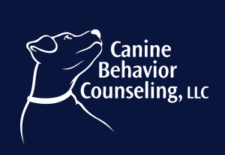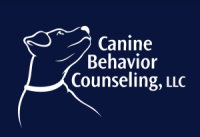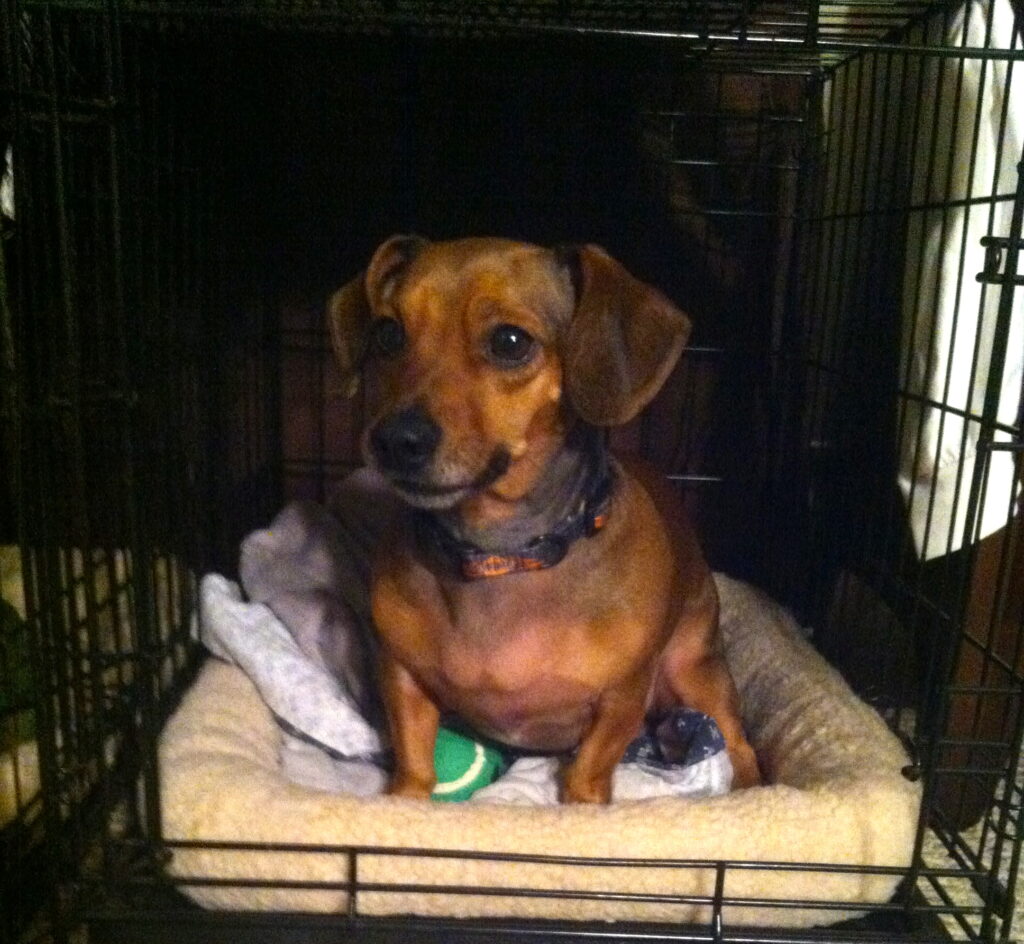I am house training an adult 3 yr old dog that has been allowed to use pee pads all his life. This handsome mix is a very shy boy and did take a day for me to be able to body handle him without him screaming. He is vetted and in good health, just has no idea where the toilet is.
Does Age Matter?
House training a new puppy or an adult rescue dog, uses the same technique, as you are assuming the dog has no idea where to eliminate. While you are conditioning a puppy a new behavior and your are counter conditioning an adult dog a different behavior needs to be considered in your time line for sure. Counter conditioning behaviors will most often take longer.
 Management:
Management:
Whenever you are unable to supervise your puppy with 100% attention, you need to place her in either a short-term or long-term confinement area, this is known as management. Management is simply a method you use to keep your dog from practicing an unwanted behavior or habit.
Your puppy can be placed in a short-term confinement area such as a crate if she will be there for less than her holding limit. The purpose of the crate is to keep her out of trouble while you are unable to supervise her, and to help you house train her. The crate should be just big enough for her to be able to lie down on her side with outstretched limbs, stand up, and turn around easily. It should not be so big that she thinks there is enough space for a bedroom and for a toilet area. When you let her out of her crate you can bring her straight outdoors for a brisk walk and reward her for doing her business in the right place.
For longer confinement periods a bigger area, with non-absorbent flooring, such as a bathroom, kitchen, or utility room, is needed. The long-term confinement area should have a bed or open crate at one end, a puppy pad or a strip of sod at the opposite end. Your puppy will naturally want to eliminate as far as possible from her bed. If the space you use for long-term confinement happens to have a door that leads to the outdoors, then place the toilet area near that door. This way, your puppy’s toilet area is as close as possible to where she should ultimately be heading to do her business. Fresh water and stuffed chew toys should also be plentiful, and should be placed near her bed.
Timing:
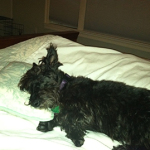
Your Puppy will naturally have the urge to eliminate after a nap, a meal, a drink, exercise, excitement, or time spent in confinement. Give your puppy the opportunity to do her business outdoors at these times. When your puppy does her business in the right place offer her a treat, plenty of praise, a game of tug in the house or a walk. After going outside, the pup should be allowed some supervised free time in the house. After an hour of free time, either confine your puppy or using a drag cord with the puppy tied to your hip is a great way to set him up for success and prevent her from having an accident.
If you would like your dog to poop promptly when you take her out, then teach your puppy that a prompt poop is her ticket to a walk around the block. This will encourage her to poop as soon as you let her out – and will allow you to leave the stinky poop bag at the house, rather than having to carry it around for much of the walk. If you do the opposite, take her for a walk, and ending her walk as soon as she does do her business, she will learn to delay pooping!
Training:
Teach your puppy or new dog that each room of the house is “his” living space as well. This can be done by feeding, playing and spending time with your dog in each room. Many dogs will assume if they are not allowed in the Living room, that must be the toilet room. When you take your puppy out, always go to the same spot and stand fairly still, this is not playtime, or hunting time, it is time to be quiet and stand still. Once the dog has made a choice to go, yea, then a game can follow!
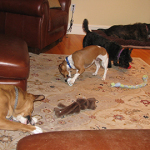
Be Consistent!
If you train your puppy to poop while on a leash M-F, then you cannot expect her to poop on Sat. in the back yard off the leash. Our puppies do not always generalize information that well, so if she is having accidents, you must consider her schedule and what you have actually taught her. Have your dog potty at the same times each day, go to the same spot, each day and use the same walking tool such as a 6 or 8 foot leash. Many dogs will not potty with their jacket on, or with their snow boots on, or with their gentle leader on at first. They may need to be taught that it is okay to do so. Remember, dogs prefer to avoid conflict, so they will avoid getting in to trouble even if that means avoiding going potty near a human.
Advantages of Using a Crate
- Keeps puppy safe when you can not watch your puppy.
- Teaches puppy to keep his area clean.
- Should never be used as punishment
- Should be used as a safe haven for your pet.
- Begin when you first bring your puppy home. Start with just a short time and increase the time as your puppy feels comfortable.
- Do lure your puppy in and out with treats so he enters on his own. Avoid shoving your puppy in and shut the door right away.
- Keep the crate in a place where your puppy can hear you talk to him.
Is Punishment Effective?
If you wait more than a few seconds after your puppy has eliminated before expressing your disapproval, your puppy will not know why she is being punished. If you catch your puppy about to pee or poop in the wrong place you can clap your hands and say “Ah-ah”, and swiftly take her up to the outdoors to continue. Punishing her after the fact just makes her anxious for you to return the next time as she will assume you will be aggressive every time you come home.
You have a Choice:
Honestly, I have met many dogs who refuse to potty when their owner is on the other end of the leash. Why? We know dogs learn through associations, so if even one time, the owner yells and swats the puppy on the nose or body for going potty in front of him, the dog learns “never potty when this human is near.” So, be patient and reward your dog when he does go in the correct place, use management to set him up for success and always train your dog in a positive way so he learn to trust you and become a companion rather than a flight risk. Enjoy the journey, bumps and all!
